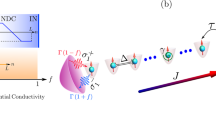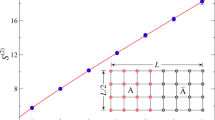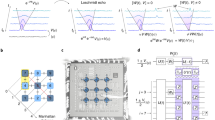Abstract
Quantum systems can be characterized by their correlations1,2. Higher-order (larger than second order) correlations, and the ways in which they can be decomposed into correlations of lower order, provide important information about the system, its structure, its interactions and its complexity3,4. The measurement of such correlation functions is therefore an essential tool for reading, verifying and characterizing quantum simulations5. Although higher-order correlation functions are frequently used in theoretical calculations, so far mainly correlations up to second order have been studied experimentally. Here we study a pair of tunnel-coupled one-dimensional atomic superfluids and characterize the corresponding quantum many-body problem by measuring correlation functions. We extract phase correlation functions up to tenth order from interference patterns and analyse whether, and under what conditions, these functions factorize into correlations of lower order. This analysis characterizes the essential features of our system, the relevant quasiparticles, their interactions and topologically distinct vacua. From our data we conclude that in thermal equilibrium our system can be seen as a quantum simulator of the sine-Gordon model6,7,8,9,10, relevant for diverse disciplines ranging from particle physics to condensed matter11,12. The measurement and evaluation of higher-order correlation functions can easily be generalized to other systems and to study correlations of any other observable such as density, spin and magnetization. It therefore represents a general method for analysing quantum many-body systems from experimental data.
This is a preview of subscription content, access via your institution
Access options
Access Nature and 54 other Nature Portfolio journals
Get Nature+, our best-value online-access subscription
$29.99 / 30 days
cancel any time
Subscribe to this journal
Receive 51 print issues and online access
$199.00 per year
only $3.90 per issue
Buy this article
- Purchase on Springer Link
- Instant access to full article PDF
Prices may be subject to local taxes which are calculated during checkout




Similar content being viewed by others
References
Schwinger, J. On the Green’s functions of quantized fields. I. Proc. Natl Acad. Sci. USA 37, 452–455 (1951)
Schwinger, J. On the Green’s functions of quantized fields. II. Proc. Natl Acad. Sci. USA 37, 455–459 (1951)
Zinn-Justin, J. Quantum Field Theory and Critical Phenomena (Oxford Univ. Press, 2002)
Peskin, M. E . & Schroeder, D. V. An Introduction to Quantum Field Theory (Westview, 1995)
Cirac, J. I. & Zoller, P. Goals and opportunities in quantum simulation. Nat. Phys. 8, 264–266 (2012)
Coleman, S. Quantum sine-Gordon equation as the massive Thirring model. Phys. Rev. D 11, 2088–2097 (1975)
Mandelstam, S. Soliton operators for the quantized sine-Gordon equation. Phys. Rev. D 11, 3026–3030 (1975)
Faddeev, L. D. & Korepin, V. E. Quantum theory of solitons. Phys. Rep. 42, 1–87 (1978)
Sklyanin, E. K., Takhtadzhyan, L. A. & Faddeev, L. D. Quantum inverse problem method. I. Theor. Math. Phys. 40, 688–706 (1979)
Gritsev, V., Polkovnikov, A. & Demler, E. Linear response theory for a pair of coupled one-dimensional condensates of interacting atoms. Phys. Rev. B 75, 174511 (2007)
Cuevas-Maraver, J., Kevrekidis, P. G. & Williams, F. (eds). The sine-Gordon Model and its Applications (Springer, 2014)
Fogel, M. B., Trullinger, S. E., Bishop, A. R. & Krumhansl, J. A. Dynamics of sine-Gordon solitons in the presence of perturbations. Phys. Rev. B 15, 1578–1592 (1977)
Bogoliubov, N. On the theory of superfluidity. J. Phys. 11, 23–32 (1947)
Landau, L. D. The theory of a Fermi liquid. Sov. Phys. JETP 3, 920–925 (1957)
Wick, G. C. The evaluation of the collision matrix. Phys. Rev. 80, 268–272 (1950)
Gardiner, C. Stochastic Methods: A Handbook for the Natural and Social Sciences Chs 2, 4, 5 (Springer, 2009)
Bloch, I., Dalibard, J. & Nascimbène, S. Quantum simulations with ultracold quantum gases. Nat. Phys. 8, 267–276 (2012)
Hodgman, S. S., Dall, R. G., Manning, A. G., Baldwin, K. G. H. & Truscott, A. G. Direct measurement of long-range third-order coherence in Bose–Einstein condensates. Science 331, 1046–1049 (2011)
Dall, R. G. et al. Ideal n-body correlations with massive particles. Nat. Phys. 9, 341–344 (2013)
Endres, M. et al. Single-site- and single-atom-resolved measurement of correlation functions. Appl. Phys. B 113, 27–39 (2013)
Langen, T. et al. Experimental observation of a generalized Gibbs ensemble. Science 348, 207–211 (2015)
Betz, T. et al. Two-point phase correlations of a one-dimensional Bosonic Josephson junction. Phys. Rev. Lett. 106, 020407 (2011)
Schumm, T. et al. Matter–wave interferometry in a double well on an atom chip. Nat. Phys. 1, 57–62 (2005)
Gring, M. et al. Relaxation and prethermalization in an isolated quantum system. Science 337, 1318–1322 (2012)
Langen, T., Geiger, R., Kuhnert, M., Rauer, B. & Schmiedmayer, J. Local emergence of thermal correlations in an isolated quantum many-body system. Nat. Phys. 9, 640–643 (2013)
Tomonaga, S. Remarks on Bloch’s method of sound waves applied to many-fermion problems. Prog. Theor. Phys. 5, 544–569 (1950)
Luttinger, J. M. An exactly soluble model of a many-fermion system. J. Math. Phys. 4, 1154–1162 (1963)
Mattis, D. C. & Lieb, E. H. Exact solution of a many-fermion system and its associated boson field. J. Math. Phys. 6, 304–312 (1965)
Whitlock, N. K. & Bouchoule, I. Relative phase fluctuations of two coupled one-dimensional condensates. Phys. Rev. A 68, 053609 (2003)
Coleman, S. Fate of the false vacuum: semiclassical theory. Phys. Rev. D 15 , 2929–2936 (1977); erratum 16, 1248 (1977)
Adu Smith, D. et al. Prethermalization revealed by the relaxation dynamics of full distribution functions. New J. Phys. 15, 075011 (2013)
Shiryaev, A. N. Probability-1 3rd edn, 349 (Springer, 2016)
Efron, B. & Tibshirani, R. Bootstrap methods for standard errors, confidence intervals, and other measures of statistical accuracy. Stat. Sci. 1, 54–75 (1986)
Grišins, P. & Mazets, I. E. Coherence and Josephson oscillations between two tunnel-coupled one-dimensional atomic quasicondensates at finite temperature. Phys. Rev. A 87, 013629 (2013)
Manz, S. et al. Two-point density correlations of quasicondensates in free expansion. Phys. Rev. A 81, 031610 (2010)
Stimming, H.-P., Mauser, N. J., Schmiedmayer, J. & Mazets, I. E. Fluctuations and stochastic processes in one-dimensional many-body quantum systems. Phys. Rev. Lett. 105, 015301 (2010)
Acknowledgements
We acknowledge discussions with E. Demler and J. M. Pawlowski. This work was supported by the EU through the EU-FET Proactive grant AQuS, Project No. 640800 and the ERC advanced grant QuantumRelax, and by the Austrian Science Fund (FWF) through the doctoral programme CoQuS (W1210) (T.S., B.R. and F.C.) and the SFB-FoQuS. This work is in part supported by the SFB 1225 ‘ISOQUANT’ financed by the German Research Foundation (DFG) and the FWF. V.K. acknowledges support from the Max Planck Society through the doctoral programme IMPRS-QD. T.L. acknowledges support by the Alexander von Humboldt Foundation through a Feodor Lynen Research Fellowship. T.G. and J.B. acknowledge support by the University of Heidelberg (Center for Quantum Dynamics) and the Helmholtz Association (HA216/EMMI).
Author information
Authors and Affiliations
Contributions
T.S., B.R., F.C. and T.L. performed the experiment and the data analysis. S.E., V.K., T.S. and I.M. did the theoretical calculations. J.S., J.B. and T.G. provided scientific guidance in experimental and theoretical questions. All authors contributed to interpreting the data and writing the manuscript.
Corresponding author
Ethics declarations
Competing interests
The authors declare no competing financial interests.
Additional information
Reviewer Information Nature thanks I. Spielman and the other anonymous reviewer(s) for their contribution to the peer review of this work.
Publisher's note: Springer Nature remains neutral with regard to jurisdictional claims in published maps and institutional affiliations.
Extended data figures and tables
Extended Data Figure 1 Parameter dependence of phase locking in thermal sine-Gordon theory.
We use the experimental observable 〈cos(φ)〉 to quantify the phase locking in a direct and model-independent way. Its dependence on the dimensionless parameter q = λT/lJ (see Methods section ‘sine-Gordon model’) is displayed for the full sine-Gordon model (dashed green line) and for the quadratic Bogoliubov model (dashed-dotted grey line), obtained by expanding the cosine to second order and valid for large phase locking. To compare experiment and theory, the finite imaging resolution needs to be taken into account (solid green line). Some experimental parameters used in the main text are marked and connected to the respective values of q.
Extended Data Figure 2 Extraction of the relative phase φ(z).
a, The two superfluids (see Fig. 1) interfere in 16 ms time-of-flight. The picture shows the resultant interference pattern recorded through absorption imaging. The colour encodes the atomic density, with red corresponding to high density and blue to low density. b, For each z value, the x-dependent atomic density is fitted with a cosine function with a Gaussian envelope25; as an example, the fit for z = 0 (dash-dotted line in a) is shown. c, The fitted phase shift of the cosine function represents (at least approximately) the in situ phase φ(z) mod 2π between the two superfluids. d, Imposing continuity onto the phase profile (by shifting the local value of the phase by multiples of 2π) gives phase differences that are not restricted to the interval [−π, π). A global ambiguity of 2πn (where n is an integer) remains.
Extended Data Figure 3 Integral measures for the thermal equilibrium data (prepared by slow evaporative cooling).
a, Relative size of the Nth-order connected correlation function as quantified by the measure M(N) (equation (5)). b, Relative deviation from the Wick decomposition as quantified by the measure  (equation (8); Methods). Both measures are plotted as a function of the phase-locking strength, which is quantified by 〈cos(φ)〉. The experimental data are plotted as red circles, with error bars representing 80% confidence intervals calculated using bootstrapping. The theoretical prediction for a large sample (105 numerical realizations) is given by the solid lines. The two lines and the shaded area in between represent the prediction for the maximum spread of the estimated experimental parameters. The green bars represent the theoretical predictions for the experimental sample sizes (typically around 1,000). The heights of the bars represent the 80% confidence intervals of the predictions and the width was chosen arbitrarily. The P values testing the null hypotheses of having Gaussian fluctuations (same sample sizes and same mean and covariance as in the experimental data) are marked as squares; values smaller than 0.02 are marked in orange, the rest in grey. See Methods for a detailed discussion of the plotted quantities and the statistical methods used.
(equation (8); Methods). Both measures are plotted as a function of the phase-locking strength, which is quantified by 〈cos(φ)〉. The experimental data are plotted as red circles, with error bars representing 80% confidence intervals calculated using bootstrapping. The theoretical prediction for a large sample (105 numerical realizations) is given by the solid lines. The two lines and the shaded area in between represent the prediction for the maximum spread of the estimated experimental parameters. The green bars represent the theoretical predictions for the experimental sample sizes (typically around 1,000). The heights of the bars represent the 80% confidence intervals of the predictions and the width was chosen arbitrarily. The P values testing the null hypotheses of having Gaussian fluctuations (same sample sizes and same mean and covariance as in the experimental data) are marked as squares; values smaller than 0.02 are marked in orange, the rest in grey. See Methods for a detailed discussion of the plotted quantities and the statistical methods used.
Extended Data Figure 4 Integral measures for the rapidly cooled data.
As for Extended Data Fig. 3, but with the experimental data plotted as blue diamonds.
Extended Data Figure 5 Decomposition of the sixth-order phase correlation functions G(6)(z, z′).
a–c, Uncoupled (〈cos(φ)〉 ≈ 0; a), intermediate (b) and strongly phase-locked (〈cos(φ)〉 ≈ 1; c) regimes. To visualize the high-dimensional data, we choose z3 = −z4 = 10 μm, z5 = − z6 = 20 μm and z′ = 0, which results in the observed symmetric crosses where the correlation function vanishes. The colour marks the value of the full, disconnected or connected correlation functions, or the difference between the full correlation functions and their Wick decompositions. Each row is normalized to its maximum absolute value such that the colour encodes the interval [−1, 1]. Although the connected part for 〈cos(φ)〉 = 0.92 is small, the deviation from the Wick decomposition is larger, in agreement with theory. Full Wick factorization requires even higher phase locking (see Extended Data Fig. 3).
Extended Data Figure 6 Decomposition of the eighth-order phase correlation functions G(8)(z, z′).
As for Extended Data Fig. 5, but with z3 = −z4 = 10 μm, z5 = −z6 = 18 μm, z7 = −z8 = 24 μm and z′ = 0. The apparent failure of the Wick decomposition for the uncoupled case (〈cos(φ)〉 ≈ 0; top right) can be attributed to the finite sample size (see Extended Data Fig. 3 and discussion in Methods).
Extended Data Figure 7 Decomposition of the tenth-order phase correlation functions G(10)(z, z′).
As for Extended Data Fig. 5, but with z3 = −z4 = 10 μm, z5 = −z6 = 15 μm, z7 = −z8 = 20 μm, z9 = −z10 = 24 μm and z′ = 0. The apparent failure of the Wick decomposition for the uncoupled case (〈cos(φ)〉 ≈ 0; top right) can be attributed to the finite sample size (see Extended Data Fig. 3 and discussion in Methods).
Supplementary information
Supplementary Information
This file contains a Supplementary discussion of the theoretical calculations and concepts used in the main text. (PDF 260 kb)
Rights and permissions
About this article
Cite this article
Schweigler, T., Kasper, V., Erne, S. et al. Experimental characterization of a quantum many-body system via higher-order correlations. Nature 545, 323–326 (2017). https://doi.org/10.1038/nature22310
Received:
Accepted:
Published:
Issue Date:
DOI: https://doi.org/10.1038/nature22310
This article is cited by
-
The Kraichnan Model and Non-equilibrium Statistical Physics of Diffusive Mixing
Annales Henri Poincaré (2024)
-
Witnessing light-driven entanglement using time-resolved resonant inelastic X-ray scattering
Nature Communications (2023)
-
Verification of the area law of mutual information in a quantum field simulator
Nature Physics (2023)
-
Observation of Cooper pairs in a mesoscopic two-dimensional Fermi gas
Nature (2022)
-
Quantum nonlinear spectroscopy of single nuclear spins
Nature Communications (2022)
Comments
By submitting a comment you agree to abide by our Terms and Community Guidelines. If you find something abusive or that does not comply with our terms or guidelines please flag it as inappropriate.



